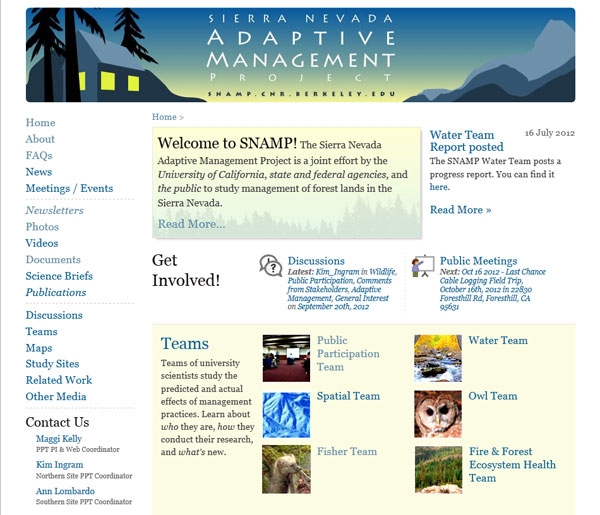Because management projects in contentious natural resource contexts often involve finding reasonable compromise or shared understandings between participants, the success (or failure) of such management is partly about communicating information. Techniques for public participation continue to evolve in order to facilitate a more comprehensive flow of information to, from, and between diverse audiences.
The Internet is part of this evolution: web-based tools provide information exchange between diverse participants and stakeholders about complex environmental systems. But how effective are these tools and do they facilitate the flow of information required in adaptive management? Maggi Kelly, UC Cooperative Extension specialist in the Department of Environmental Science, Policy and Management at UC Berkeley, and Lynn Huntsinger, professor in ESPM at Berkeley, and graduate students Shasta Ferranto, Ken-ichi Ueda and Shufei Lei examined the role of the web in facilitating public participation through a case study - the Sierra Nevada Adaptive Management Project (SNAMP) - a participatory adaptive management project focused on Forest Service vegetation management treatments in California’s Sierra Nevada with a participatory website.
Analyzing three years of website traffic data from Google Analytics, researchers found that the SNAMP website received over 71,000 unique visits from the United States and other countries. Site traffic peaked when quarterly “web updates”- emails sent out to stakeholders with information about the project and any updates - were sent. The data from an email survey conducted by the SNAMP Public Participation Team in 2010 showed that most survey respondents (72.2 percent) had visited the website. Email survey respondents also agreed that the website helped them keep up with SNAMP events, increased information transparency, was easy to use, and was a good source of information. The web also played a small, but important role in public consultation, by providing a discussion board for targeted questions and feedback between the public and SNAMP scientists. However, Internet technology did not actively support the two-way flow of information necessary for mutual learning. It complements, but does not substitute for, face-to-face interactions and public meetings; does not facilitate three-party conversations very well; and has a very small user base to generate sufficient online content and dialogue.

Based on this case study, public participation is most effective when a combination of participatory tools are used, including the web, public meetings, active outreach, and open channels of communication for reaching a broad pool of participants needed for social networking. Website design should be adaptive, and website evolution and maintenance should be budgeted ahead and funded. User needs assessments are necessary to understand how the users collaborate and interact during the life of a project.
Full Reference: M.Kelly, S.Ferranto, K.Ueda, S.Lei, and L.Huntsinger. 2012. Expanding the table: the web as a tool for participatory adaptive management in California forests. Journal of Environmental Management 109: 1-11.